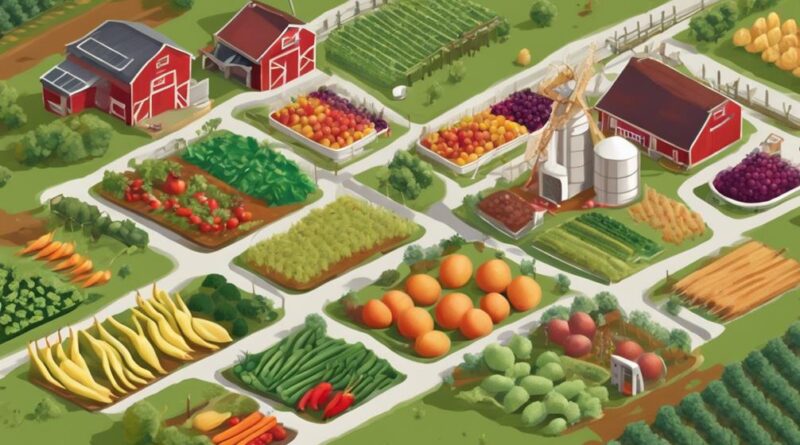Natural Vs Conventional Foods: a Safety Analysis
When it comes to the food you consume daily, have you ever wondered about the safety behind natural versus conventional options? The debate over which is better for you continues to spark curiosity and concern among consumers.
As you navigate through the aisles of your grocery store, you may find yourself contemplating the potential risks associated with each choice.
Stay tuned to discover the key factors that differentiate natural from conventional foods, shedding light on important aspects that can impact your health and well-being.
Food Safety Standards for Organic Products
When it comes to organic products, ensuring food safety is a critical aspect that can't be overlooked. Organic certification plays a vital role in guaranteeing that the food you consume meets specific standards. To be labeled organic, products must adhere to stringent guidelines set by certification bodies that regulate farming practices to ensure the use of natural inputs and sustainable methods. These farming practices emphasize environmental conservation, promoting biodiversity, and prohibiting the use of synthetic pesticides and fertilizers.
Organic certification verifies that farmers follow strict protocols that prioritize soil and water conservation, reducing pollution, and promoting ecological balance. By embracing methods such as crop rotation, composting, and biological pest control, organic farming minimizes the impact on the environment while producing food that's free from harmful chemicals. Consumers who choose organic products can have confidence in the integrity of the food they purchase, knowing that it has been cultivated in a manner that aligns with their values of health and sustainability.
Pesticide Residue Comparison Studies
Ensuring food safety through organic certification is crucial, and a key aspect to consider when comparing natural and conventional foods lies in examining pesticide residue levels. Residue testing is a critical component of food safety assessments. Studies have shown that organic produce generally has lower levels of pesticide residues compared to conventionally grown produce. This is due to the strict regulations in place for organic farming, which prohibit the use of synthetic pesticides and herbicides.
Pesticide regulations differ between organic and conventional farming practices. Organic farmers must adhere to stringent rules regarding the types of pesticides they can use, focusing on natural alternatives like plant-based oils and beneficial insects. On the other hand, conventional farmers have a wider range of synthetic pesticides at their disposal, which may leave higher residue levels on the final food products.
Residue testing plays a vital role in ensuring that food products meet safety standards. By comparing pesticide residue levels in natural and conventional foods, consumers can make informed choices about the products they purchase. Opting for organic options may reduce exposure to potentially harmful chemicals present in pesticide residues. Ultimately, understanding the differences in residue levels between natural and conventional foods is essential for promoting food safety and making informed dietary decisions.
Health Risks Associated With Conventional Foods
Comparing natural and conventional foods, one significant concern revolves around the health risks associated with consuming conventionally grown produce. Chemical exposure risks are a major issue with conventional foods due to the use of synthetic pesticides and fertilizers. These chemicals can leave residue on the produce, which may have health implications when consumed over time. Research has shown that prolonged exposure to these chemical residues could potentially lead to various health problems, ranging from minor issues like skin irritation to more severe conditions like certain types of cancer.
In addition to chemical exposure risks, conventional foods also pose a threat in terms of foodborne illness outbreaks. The intensive farming practices often associated with conventional agriculture can increase the chances of contamination by pathogens such as E. coli and Salmonella. To mitigate these risks, it's crucial for food producers to adhere to strict safety protocols and regulations. Consumers can also play a part in preventing foodborne illnesses by following proper food handling and preparation practices at home.
Antibiotic Use in Conventional Farming
Antibiotics are commonly utilized in conventional farming practices to promote animal growth and prevent diseases. While this practice has its benefits, such as increased production efficiency, it also raises concerns regarding antibiotic resistance and animal welfare.
The use of antibiotics in animal farming has contributed to the development of antibiotic-resistant bacteria. This poses a significant threat to public health as these resistant bacteria can be transmitted to humans through the consumption of meat products or through environmental contamination. The overuse of antibiotics in farming is a major factor driving the emergence of antibiotic-resistant strains, making it harder to treat infections in both animals and humans.
In addition to the issue of antibiotic resistance, the use of antibiotics in conventional farming can also impact animal welfare. The routine administration of antibiotics to prevent disease in crowded and stressful farming conditions can mask underlying health issues in animals. This can lead to prolonged suffering for sick animals without proper treatment and care.
As a consumer, being aware of the implications of antibiotic use in conventional farming is crucial. By supporting sustainable and ethical farming practices that prioritize animal welfare and reduce reliance on antibiotics, you can help promote a safer food system for both animals and humans.
Organic Vs Conventional Food Contaminants
When considering the safety of natural and conventional foods, the presence of contaminants is a critical factor to evaluate. Contaminant levels in foods can vary between organic and conventional products due to differences in farming practices. Organic certification plays a key role in regulating the amount of contaminants present in organic foods.
Organic foods are produced without the use of synthetic pesticides, fertilizers, or genetically modified organisms (GMOs). These practices result in lower levels of contaminants such as pesticides, heavy metals, and artificial additives in organic foods compared to conventional products. Organic certification ensures that organic farmers adhere to strict guidelines regarding the use of chemicals and pesticides, thus reducing the risk of contamination.
On the other hand, conventional farming methods involve the use of synthetic pesticides and fertilizers to maximize crop yields. These practices can lead to higher levels of pesticide residues, heavy metals, and other contaminants in conventional foods. Consumers who choose conventional products may be exposed to a greater variety and quantity of contaminants compared to those who opt for organic options.
Environmental Impact of Organic Farming
Organic farming practices significantly impact the environment through sustainable cultivation methods and reduced chemical usage. By prioritizing sustainability practices, organic farming aims to preserve soil health and promote long-term ecological balance. One key aspect of organic farming is the emphasis on maintaining soil health through techniques such as crop rotation, composting, and the use of natural fertilizers like manure and compost. These practices help improve soil structure, enhance water retention, and foster biodiversity, contributing to the overall health of the ecosystem.
Furthermore, organic farming reduces the reliance on synthetic pesticides and fertilizers, which can have detrimental effects on the environment. By avoiding the use of these chemicals, organic farmers help protect water sources from contamination and support the health of pollinators and other beneficial insects essential for ecosystem functioning. The avoidance of genetically modified organisms (GMOs) in organic farming also plays a role in preserving biodiversity and preventing potential harm to non-target species.
Food Additives and Organic Labeling

Minimize your exposure to potentially harmful food additives by scrutinizing organic labeling for transparency on ingredient quality. When it comes to food additives and organic labeling, it's crucial to prioritize ingredient transparency and consumer trust. Here are some key points to consider:
- Ingredient Transparency: Organic labeling often provides detailed information about the ingredients used in the product, allowing you to make more informed choices about what you consume.
- Consumer Trust: Organic certifications require adherence to strict standards, fostering trust between consumers and producers regarding the quality and sourcing of ingredients.
- Regulatory Oversight: Organic products are subject to regulatory oversight to ensure that they meet specific criteria for organic certification, providing an additional layer of consumer protection.
- Ethical Sourcing: Organic labeling may indicate that ingredients have been ethically sourced, promoting sustainable and responsible production practices.
- Avoiding Harmful Additives: By choosing organic products with transparent labeling, you can reduce your exposure to potentially harmful additives commonly found in conventional foods.
Consumer Awareness and Food Choices
Enhancing consumer awareness empowers you to make informed and health-conscious food choices. When it comes to selecting between natural and conventional foods, ingredient transparency and nutritional value play crucial roles in your decision-making process. Understanding what goes into your food and how it can impact your health is essential. Natural foods often boast minimal processing and simpler ingredients, which can be appealing for those looking to avoid additives or artificial substances commonly found in conventional foods.
Price comparison is another factor influencing consumer choices. While natural foods may sometimes come at a higher price point, many individuals prioritize their health and are willing to invest in products they perceive as healthier or more environmentally friendly. Consumer preferences vary, with some opting for conventional foods due to convenience or cost-effectiveness, while others prioritize natural options for their perceived health benefits.
Frequently Asked Questions
Are There Any Long-Term Health Effects That Could Arise From Consuming Natural or Conventional Foods?
When it comes to the long-term effects of consuming natural or conventional foods, it's essential to consider the nutritional content. Both types of food can impact your health over time.
Pay attention to how these foods affect your body and make informed choices based on your individual needs. Monitoring your diet and consulting with a healthcare professional can help you maintain a balanced and healthy lifestyle in the long run.
How Do Natural and Conventional Farming Practices Impact Local Wildlife and Ecosystems?
When comparing natural and conventional farming practices, you'll see differences in how they impact local wildlife and ecosystems.
Natural farming tends to have a lower impact on biodiversity and supports ecosystem health by working with nature rather than against it.
On the other hand, conventional methods often involve the use of chemicals and monocultures, which can harm wildlife and disrupt the balance of ecosystems.
It's essential to consider these factors when choosing between the two approaches.
Can Organic Foods Be Genetically Modified or Contain Gmos?
Yes, organic foods can be genetically modified or contain GMOs if not certified as non-GMO. When looking at organic labeling, it's essential to understand that organic farming practices generally prohibit the use of biotechnology.
However, without proper certification, there's a possibility of GMO presence in organic products. To ensure GMO-free organic foods, look for the non-GMO certification on the packaging for added reassurance.
Are There Any Differences in Nutrient Levels Between Natural and Conventional Foods?
When comparing nutrient levels in natural and conventional foods, you'll find variations that can impact your health. Organic foods often boast higher nutrient content, offering potential benefits for your well-being.
On the other hand, conventional foods might lack some essential nutrients due to farming practices. Understanding these differences can help you make informed choices for a balanced diet, ultimately influencing your overall health and vitality.
How Do the Costs of Natural and Conventional Foods Compare in Terms of Overall Value and Affordability?
When comparing natural and conventional foods, cost comparison is crucial for determining overall value and affordability. Consider factors like nutritional value and prices to make informed choices.
Look for sales or discounts to optimize your budget. Pay attention to labels and ingredients to ensure you're getting the best value for your money.
Find a balance between cost and quality that suits your needs.
Conclusion
In conclusion, when it comes to natural vs conventional foods, choosing organic options can provide a safer and healthier choice for consumers. With stricter food safety standards, fewer pesticide residues, and minimal use of antibiotics, organic foods offer a cleaner and more environmentally friendly option.
It's important for consumers to be aware of the potential health risks associated with conventional foods and make informed decisions to prioritize their well-being. Choose organic for a safer and more sustainable food choice.
